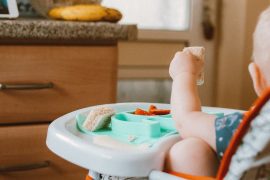By Aileen Dunbar
Do you feel like your child is glued to your leg right now and you can’t seem to catch a break? This may mean they are going through a peak in separation anxiety. In this post, I will delve into the causes of this as well as some strategies to help ease some of the anxiety your child feels when they are separated from you.
Introduction to separation anxiety
Separation anxiety is the feelings of fear, discomfort, and sadness that develop when a child is separated from their caregiver. It is based on that primal instinct to be with those who care for them as well as a not yet fully developed brain that is still in the process of learning that when people leave, they will return.
When does it develop?
- It develops in infancy as babies start to gain an understanding of object permanence, which is an awareness that objects and people still exist even when they can’t be detected with the senses such as sight, hearing, etc.
- The time at which this awareness develops differs for each baby but on average, may start around the 6-month mark but then heightens at different periods such as at 9 months, 12 months, 18 months, and 24 months.
- The level to which each child experiences separation anxiety may be influenced by various factors including their unique temperament, birth experiences (such as if they spent any time in the NICU, for example), how a parent deals with and feels about separations, and whether they are going through developmental leaps among others.
It is based on that primal instinct to be with those who care for them as well as a not yet fully developed brain that is still in the process of learning that when people leave, they will return.
Strategies to help ease separation anxiety at different stages
A. Tips during the infancy stage (6 months-12 months)
Offer them lots of contact and closeness to help them feel more secure during this time. This could look different for each baby, but some examples are using contact or carrier naps, putting them in the carrier and/or keeping them close by to do daily tasks such as cleaning and cooking, and spending connected, distraction-free time with the baby throughout the day.
Use games to help further their understanding that even when they can’t see you, you still exist and will return. An example of one such game is “Peekaboo” where you cover your face, then uncover it to show them that even though they couldn’t see you, you were still there. Another example is “Leave and Return” where you leave the room for a moment with the baby in a safe space, and then return with a happy expression to show them that even if you leave them, you will return.
Make sure you say goodbye before you leave instead of sneaking out to build trust and security.
Call on your village when you need a break. Since peaks in separation anxiety can be extra demanding on the primary caregiver, it is important that others in your village such as your partner if you have one or other family members can help so you can have some self-care time. Even if it is just a short break to watch your favorite show, go for a walk by yourself or have a relaxing bath, make sure you prioritise this time.
If you are going to be leaving baby, do all you can to make it as pleasant an experience as possible. Some ways to do this are: spend quality time together before you head out; leave them with a caregiver who they are used to and comfortable with; prepare them for the transition ahead of time and tell them when you will return (ex. “After dinner tonight, Grandma will be coming over to watch you while Daddy and I go out for a bit. We will be back before bedtime.”); make sure you say goodbye before you leave instead of sneaking out to build trust and security; ensure the caretaker watching baby follows similar routines when you are gone to help baby feel more at ease.











